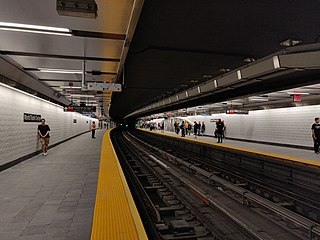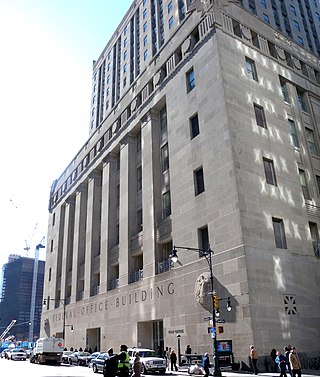
Battery Park City is a mainly residential 92-acre (37 ha) planned community and neighborhood on the west side of the southern tip of the island of Manhattan in New York City. It is bounded by the Hudson River on the west, the Hudson River shoreline on the north and south, and the West Side Highway on the east. The neighborhood is named for the Battery, formerly known as Battery Park, located directly to the south.

The World Trade Center site, often referred to as "Ground Zero" or "the Pile" immediately after the September 11 attacks, is a 14.6-acre (5.9 ha) area in Lower Manhattan in New York City. The site is bounded by Vesey Street to the north, the West Side Highway to the west, Liberty Street to the south, and Church Street to the east. The Port Authority of New York and New Jersey (PANYNJ) owns the site's land. The original World Trade Center complex stood on the site until it was destroyed in the September 11 attacks.

Brookfield Place is a shopping center and office building complex in the New York City borough of Manhattan. It is located in the Battery Park City neighborhood, across West Street from the World Trade Center, and overlooks the Hudson River. The complex is currently owned and managed by Brookfield Properties, a subsidiary of Brookfield Asset Management.

The Lower Manhattan Development Corporation was formed in November 2001, following the September 11 attacks, to plan the reconstruction of Lower Manhattan and distribute nearly $10 billion in federal funds aimed at rebuilding downtown Manhattan. It is a subsidiary of the Empire State Development Corporation, which is a New York state public-benefit corporation.

The WTC Cortlandt station is a station on the IRT Broadway–Seventh Avenue Line of the New York City Subway in the Financial District of Manhattan. The station is located under the intersection of Greenwich Street and Cortlandt Way within the World Trade Center. It is served by the 1 train at all times.

The Manhattan Community Board 1 is a New York City community board encompassing the neighborhoods of Battery Park City, the Financial District, the South Street Seaport, and TriBeCa in Lower Manhattan in the borough of Manhattan as well as Liberty Island, Ellis Island and Governors Island. It is bounded by Baxter Street, Pearl Street, the Brooklyn Bridge and the East River on the east, Upper New York Bay on the south, the Hudson River on the west and Canal Street on the north.

World Trade Center station is a terminal station on the PATH system, within the World Trade Center complex in the Financial District of Manhattan, New York City. It is served by the Newark–World Trade Center line at all times, as well as by the Hoboken–World Trade Center line on weekdays, and is the eastern terminus of both.

The Eighth Avenue Line is a public transit line in Manhattan, New York City, running mostly along Eighth Avenue from Lower Manhattan to Harlem. Originally a streetcar line, it is now the M10 bus route and the M20 bus route, operated by the New York City Transit Authority. The M10 bus now only runs north of 57th Street, and the M20 runs south of 66th Street. The whole line was a single route, the M10, until 2000 when the M20 was created.

The Manhattan Waterfront Greenway is a waterfront greenway for walking or cycling, 32 miles (51 km) long, around the island of Manhattan, in New York City. The largest portions are operated by the New York City Department of Parks and Recreation. It is separated from motor traffic, and many sections also separate pedestrians from cyclists. There are three principal parts — the East, Harlem and Hudson River Greenways.

Chambers Street is a two-way street in the New York City borough of Manhattan. It runs from River Terrace, Battery Park City in the west, past PS 234, The Borough of Manhattan Community College, and Stuyvesant High School, to the Manhattan Municipal Building at 1 Centre Street in the east. Between Broadway and Centre Street, Chambers Street forms the northern boundary of the grounds surrounding New York City Hall and the Tweed Courthouse. Opposite the Tweed Courthouse sits the Surrogate's Courthouse for Manhattan. 280 Broadway the Marble Palace, lies west of there, on the north side of Chambers.

Washington Street is a north–south street in the New York City borough of Manhattan. It runs in several distinct pieces, from its northernmost end at 14th Street in the Meatpacking District to its southern end at Battery Place in Battery Park City. Washington Street is, for most of its length, the westernmost street in lower Manhattan other than West Street. The exceptions are a one-block segment in the West Village where Weehawken Street lies between West and Washington Streets, and in Battery Park City.

Greenwich Street is a north–south street in the New York City borough of Manhattan. It extends from the intersection of Ninth Avenue and Gansevoort Street in the Meatpacking District at its northernmost end to its southern end at Battery Park. Greenwich Street runs through the Meatpacking District, the West Village, Hudson Square, and Tribeca.

4 World Trade Center is a skyscraper constructed as part of the new World Trade Center in Lower Manhattan, New York City. The tower is located on Greenwich Street at the southeastern corner of the World Trade Center site. Fumihiko Maki designed the 978 ft-tall (298 m) building. It houses the headquarters of the Port Authority of New York and New Jersey (PANYNJ).

The Barclay–Vesey Building is an office and residential building at 140 West Street in Lower Manhattan, New York City. The 32-story building was designed in the Art Deco style by Ralph Walker of Voorhees, Gmelin and Walker, and was Walker's first major commission as well as one of the first Art Deco skyscrapers. It occupies the entire block bounded by West Street to the west, Barclay Street to the north, Vesey Street to the south, and Washington Street to the east, abutting the World Trade Center.

Church Street and Trinity Place form a single northbound roadway in Lower Manhattan, New York City. Its northern end is at Canal Street and its southern end is at Morris Street, where Trinity Place merges with Greenwich Street. The dividing point is Liberty Street.

Vesey Street is a street in New York City that runs east-west in Lower Manhattan. The street is named after Rev. William Vesey (1674–1746), the first rector of nearby Trinity Church.

200 West Street is the global headquarters of the Goldman Sachs investment banking firm in the Battery Park City neighborhood of Manhattan in New York City. The building is a 749-foot-tall (228 m), 44-story building located on West Street, between Vesey and Murray Streets in Lower Manhattan. It is adjacent to Brookfield Place and the Conrad Hotel, the Verizon Building, and the World Trade Center. It is the only office building in Battery Park City north of Brookfield Place, and it is also the tallest building located within Battery Park City.

Liberty Park is a one-acre (0.40 ha) elevated public park at the World Trade Center in Manhattan, New York City, overlooking the National September 11 Memorial & Museum in Lower Manhattan. The park, which opened on June 29, 2016, is located above the World Trade Center's Vehicular Security Center. The St. Nicholas National Shrine is located within the park, as well as Fritz Koenig's The Sphere, the iconic sculpture salvaged from the World Trade Center site. Another statue, America's Response Monument, is also located in the park.

The World Trade Center (WTC) is a complex of buildings in the Lower Manhattan neighborhood of New York City, replacing the original seven buildings on the same site that were destroyed in the September 11 attacks of 2001. The site is being rebuilt with up to six new skyscrapers, four of which have been completed; a memorial and museum to those killed in the attacks; the elevated Liberty Park adjacent to the site, containing the St. Nicholas Greek Orthodox Church and the Vehicular Security Center; the Perelman Performing Arts Center; and a transportation hub. The 104-story One World Trade Center, the tallest building in the Western Hemisphere, is the lead building for the new complex.
























